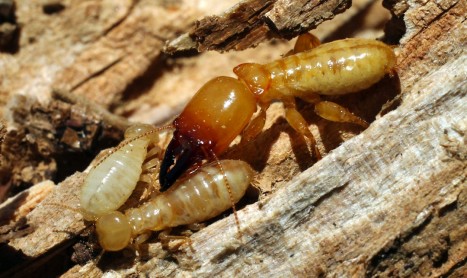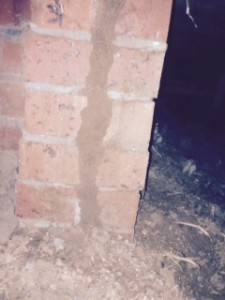
TERMITE INFESTATION MELTON SOUTH
Pest Control Empire recently responded to a call from a concerned homeowner in Melton South who investigated a creaky floor and located an active termite infestation. Unfortunately the homeowner panicked and tipped petrol on the termites that he could see. While the petrol may kill the termites that it directly contacts, it will have no effect on those that it does not. It also has no impact at all on eliminating the termite colony. The homeowner called in the team at Pest Control Empire who subsequently conducted a thorough visual termite inspection according to Australian Standard 3660.2. If you require a termite inspection please see the attached information: Termite Inspections.
A large infestation was detected and recommendations were made to treat the problem. In the attached image, which was taken in the subfloor of the Melton South home, you can see what we call a mud tunnel, which had been built up a brick pier that supports the floor. Thousands of termites will travel through this mud tunnel that leads from the soil into the home. Termites are fragile creatures that will desiccate (dry out) when exposed to light and large volumes of air. To survive outside of their natural habitat, which is soil, they must build mud tubes or mud tunnels through which to travel. This allows them to stay moist and prevent desiccation. The sighting of these mud tunnels is a dead giveaway that termites are in your home.

The piers in this subfloor are a mix of brick and concrete. Termites cannot tunnel through these types of materials. Therefore, in order to find food (wood), they build mud tunnels up these piers. If the piers were made from wood this would allow for termites to gain concealed access into the home as they could have tunnelled through the wooden piers without detection. Concrete and brick piers mean that termites must expose themselves.
It is for this reason that the Australian Standard recommends a termite inspection take place at least annually. For locations that are particularly conducive to infestation it is recommended that inspections take place at far more frequent intervals, sometimes even monthly. Now that we had identified the entry points, of which there were seven, we devised a plan to destroy the termites. The aim of any plan is to eliminate the colony, although it is nearly impossible to confirm if this has in fact transpired.
In this instance, we recommended above ground bait stations to be installed at the points of entry and in known feeding locations. The customer agreed to the proposal and we then set about setting up the stations. In the installation process it is extremely important to cause the least disruption to the termites as possible. They are very cautious and the slightest disruption may raise alarm bells and cause them to abort the tunnel that was disturbed and retreat back to the colony. The chance that this particular path will be used again is very remote.
Several bait stations were installed although it is important to leave at least one entry point undisturbed. After 14-21 days has passed since installation it is then time to conduct a follow up assessment. The entry point that did not have a bait station installed should then be inspected by gently opening up a section of the mud tunnel. If termites are sighted the baiting program has yet to be successful. If no termites are present it is likely that the baiting program has been successful. If termites are present then bait needs to be reapplied and a further inspection date booked.
We are scheduled to return to the Melton South home to check on the progress of the baiting program. We are hoping for immediate success but should termites still be present, we will continue on with the treatment until success is achieved.
Another option that we had available is known as termite dusting. Here we create small insertions into identified points of entry and known workings. We then inject a dust application in the point of entry and subsequent points along the workings. This is method requires precision as termites are easily alarmed. Should you create too much of a disturbance the particular route of travel will be closed off and a new one created.
The injected dust is intended to come into contact with termites that then transport it back to the colony. Through the ‘transfer effect’ other termites that have been fed and groomed by the infected insects should also suffer the same fate at those who have direct contact.
If no termites were located it is still advisable to have some form of termite treatment. This may consist of a liquid treatment to the inside of the substructure walls and around the piers. If possible, a barrier should also be sprayed around the exterior walls. Issues arise with exterior perimeter treatments are landscaping, concrete and paver paths usually abut exterior walls.
In many instances the soil level needs to be reduced or if concrete paths are present the concrete can be cut to allow for a complete barrier. Often this is not feasible and in these instances holes can be drilled 150mm apart and injected with the liquid. The chances of creating a complete barrier in these situations cannot be guaranteed.
It is important that the company you engage complies with Australian Standards and industry best practice. You should always ask for a copy of an inspection report. Should termites be located, you should also be provided with a termite treatment proposal. Once a treatment is completed, a termite treatment certificate and durable notice should be provided. The durable notice is to be placed into the meter box for future reference.
If you require a termite inspection you can be sure that the team at Pest Control Empire are very experienced in this field. We hold all required licenses and insurance and provide a guarantee for all work undertaken. To be sure what’s happening between your four walls be sure to contact1300 665 573 to book your next inspection. It may be the smartest call you ever make.
